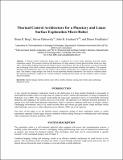Thermal Control Architecture for a Planetary and Lunar Surface Exploration Micro-Robot
Author(s)
Burg, Brian R; Dubowsky, Steven; Lienhard, John H; Poulikakos, Dimos
DownloadAccepted version (222.9Kb)
Publisher Policy
Publisher Policy
Article is made available in accordance with the publisher's policy and may be subject to US copyright law. Please refer to the publisher's site for terms of use.
Terms of use
Metadata
Show full item recordAbstract
A thermal control architecture design study is conducted for a novel robotic planetary and lunar surface exploration concept. The concept is based on the deployment of a large number of small spherical mobile robots over large areas, which employ hopping, bouncing and rolling as means of locomotion. The aim of the research is to prevent freezing and overheating of the robots, without compromising their mechanical and thermal reliability and stability. The proposed thermal control architecture relies on a low emissive silver surface coating and a low conductive silica aerogel insulation layer. This enables a single design to be used for several important potential explorations. The effects of a thermal control heat rejection mechanism, composed of a variable emittance coating and heat switch, are also studied in order to increase mission flexibility. © 2007 American Institute of Physics.
Date issued
2007Department
Rohsenow Kendall Heat Transfer Laboratory (Massachusetts Institute of Technology)Journal
AIP Conference Proceedings
Publisher
AIP
Citation
Burg, Brian R, Dubowsky, Steven, Lienhard, John H and Poulikakos, Dimos. 2007. "Thermal Control Architecture for a Planetary and Lunar Surface Exploration Micro-Robot." AIP Conference Proceedings, 880 (1).
Version: Author's final manuscript